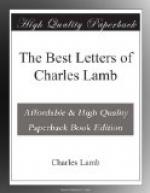My tailor has brought me home a new coat lapelled, with a velvet collar. He assures me everybody wears velvet collars now. Some are born fashionable, some achieve fashion, and others, like your humble servant, have fashion thrust upon them. The rogue has been making inroads hitherto by modest degrees, foisting upon me an additional button, recommending gaiters; but to come upon me thus in a full tide of luxury, neither becomes him as a tailor or the ninth of a man. My meek gentleman was robbed the other day, coming with his wife and family in a one-horse shay from Hampstead; the villains rifled him of four guineas, some shillings and halfpence, and a bundle of customers’ measures, which they swore were bank-notes. They did not shoot him, and when they rode off he addressed them with profound gratitude, making a congee: “Gentlemen, I wish you good-night; and we are very much obliged to you that you have not used us ill!” And this is the cuckoo that has the audacity to foist upon me ten buttons on a side and a black velvet collar,—a cursed ninth of a scoundrel!
When you write to Lloyd, he wishes his Jacobin correspondents to address him as Mr. C. L. Love and respects to Edith. I hope she is well.
Yours sincerely,
C. LAMB.
[1] This quaint scholar, a marvel of simplicity and universal optimism, is a constantly recurring and delightfully humorous character in the Letters. Lamb and Dyer had been schoolfellows at Christ’s Hospital.
[2] John Woodvil.
[3] Coleridge and Wordsworth, who started for Germany together.
XVIII.
TO SOUTHEY.
March 20, 1799,
I am hugely pleased with your “Spider,” “your old freemason,” as you call him. The three first stanzas are delicious; they seem to me a compound of Burns and. Old Quarles, those kind of home-strokes, where more is felt than strikes the ear,—a terseness, a jocular pathos which makes one feel in laughter. The measure, too, is novel and pleasing. I could almost wonder Rob Burns in his lifetime never stumbled upon it. The fourth stanza is less striking, as being less original. The fifth falls off. It has no felicity of phrase, no old-fashioned phrase or feeling.
“Young hopes, and love’s delightful dreams,”
savor neither of Burns nor Quarles; they seem more like shreds of many a modern sentimental sonnet. The last stanza hath nothing striking in it, if I except the two concluding lines, which are Burns all over. I wish, if you concur with me, these things could be looked to. I am sure this is a kind of writing which comes tenfold better recommended to the heart, comes there more like a neighbor or familiar, than thousands of Hamnels and Zillahs and Madelons. I beg you will send me the “Holly-tree,” if it at all resemble this, for it must please me. I have never seen it. I love this sort of poems,




